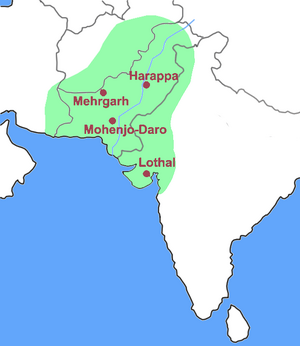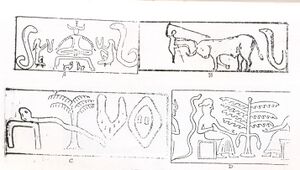Harappa
| Author:Laxman Burdak, IFS (R) |


Harappa (हड़प्पा) (Hariyupia) in the Sahiwal District of Pakistan has been settled from the pre-historical era. It is a site of Indus Valley Civilization.
Location
Harappa is an archaeological site, about 35 km (22 mi) west of Sahiwal, that was built approximately 2600 BCE. The area was part of South Asian empires and in crossroads of migrations and invasions from Central Asia. The current village of Harappa is 6 km (3.7 mi) from the ancient site.
जाट वीरों का इतिहास: दलीप सिंह अहलावत
दलीप सिंह अहलावत[1] लिखते हैं: हड़प्पा और मोहन-जोडड़ो - ऐरावती नदी पर स्थित हड़प्पा नगर क्षुद्रकों का एक पुराना नगर प्रतीत होता है। सिन्धुगत मोहन-जोदड़ो नगर इन क्षुद्रकों के साथी अन्य असुरों का नगर था। सतलुज से रावी नदी के आसपास तक क्षुद्रक देश था। वहां से मिली पुरातन-मुद्राओं पर अंकित लिपि असुर-लिपि है। असुर-लिपि में मीन अथवा मत्स्य की आकृति का प्रयोग क्षुद्र-मीना शब्द से प्रकट है। भारतीय इतिहास को न जानते हुए, पाश्चात्य लेखक जॉन मार्शल, मैके और उनके साथी इस विषय में वृथा कल्पनाएं कर रहे हैं। हड़प्पा की स्थिति भारतीय इतिहास में अत्यन्त स्पष्ट है। यूरोप और अमेरिका के लेखकों की कल्पनाओं का इसमें स्थान नहीं। हड़प्पा और मोहन-जोदड़ो के कला-कौशल को वेदकाल से पूर्व का कहना अज्ञान प्रकट करना है। यह कला-कौशल महाभारत युद्ध के काल के आसपास का है।[2]
अश्वमेध यज्ञ की स्मृति रक्षार्थ अर्जुन ने मोहन-कृष्ण और युधरो-युधिष्ठिर के नाम पर मोहन-जोदरो-मोहनजोदड़ो नामक नगर बसाया। किन्तु आर से चार सौ वर्ष पूर्व तक ही इसकी स्थिति का इतिहास मिलता है। इसके बाद का काल इस नगरी के लिए सर्वथा अन्धकारमय रहा। किन्तु समीप की खुदाइयों में सिन्ध के लरकाना जिला में N.W.R. स्टेशन से आठ मील दूरी पर मोहनजोदड़ो नगरी के मकान, सड़क, तालाब, मूर्तियां, हड्डियां, आभूषण आदि वस्तुएं प्राप्त हुई हैं, जिसके आधार पर तत्कालीन सिन्धु-सभ्यता का बड़ा विशद एवं उन्नत परिचय प्राप्त हुआ है। उस समय से भी पूर्व वहां जट्टसंघ का प्रजातन्त्री शासन था। सिन्धु देश का साहित्य इसका साक्षी है। “बंगला विश्वकोष” जिल्द 7 पृष्ठ 6 पर लिखा है कि - पूर्वे सिन्धुदेश जाट गणेर प्रभुत्व थीलो - जाट रमणीगण सुन्दर च औ सतीत्व जन्य सर्वत्र प्रसिद्ध होई। अर्थात् प्राचीनकाल में सिन्धु देश में जाटों का गणराज्य था। और जाटवंश (कुल) बालायें अपने सौन्दर्य और सतीत्व के लिए सर्वत्र प्रसिद्ध हैं।[3]
Harappan culture
The Indus Valley Civilization (also known as Harappan culture) has its earliest roots in cultures such as that of Mehrgarh, approximately 6000 BCE. The two greatest cities, Mohenjo-daro and Harappa, emerged circa 2600 BCE along the Indus River valley in Punjab and Sindh.[5] The civilization, with a writing system, urban centers, and diversified social and economic system, was rediscovered in the 1920s after excavations at Mohenjo-daro (which means "mound of the dead") in Sindh near Sukkur, and Harappa, in west Punjab south of Lahore. A number of other sites stretching from the Himalayan foothills in east Punjab, India in the north, to Gujarat in the south and east, and to Balochistan in the west have also been discovered and studied.
Anthropometrical study
Hukum Singh Panwar states:[4] Whatever little but, nonetheless, important evidence is readily available to us from the internal and external sources, may be pressed into service for the anthropometrical study of the Rigvedic tribes under review. Recent investigations based on latest techniques, employed by Dr. Partap C. Datta, in the study of skeletal remains from Harappan (Hariyupia) indicate that the mean estimate of the stature of the Harappa males is 1691-87 mm or about 5 feet 8 inches and the females, 155.59 mm or about 5 ft. 2 inches, moderately dolichocephalic and highly mesorrhine, and in taxonomy they are sexually homogeneous261. It may be observed here that the stature of the Harappans dwindled due, probably, to paucity of nutritious food on account of gradually
The Jats:Their Origin, Antiquity and Migrations: End of p.157
increasing desiccation of the domain of the Harappan culture which resulted in its destruction and also because of their deprivation of the male virile force of their ancestors who were consumed up in the Rigvedic wars.
The Harappan Civilization and cult of Naga Worship

Dr Naval Viyogi[5]writes that The Indus Valley Civilization which is the most ancient civilization of India, was spread up in North-West: Harappa, Mohenjodaro , Chanhudaro and Lothal were its most important towns. The founders of Indus valley civilization were Mediterraneans or Dravidians and Australoids, [6] where as, round headed Alpines, appeared, in mature age of this culture. [7] In excavation of these towns, in addition to Burnished Red ware, a very high number of seals and seal impressions have also been found out. Among the seals so found out on one seal, there is a figure of chief deity with buffalo head, on its both sides, are two other man deities and behind each of them is a serpent in standing posture (See Illustration - Seal A). On another seal, there is a serpent, in standing posture, behind the bull, which is fighting with a mighty man (See Illustration - Seal B). [8] On another third seal, there is a serpent resting his head on a Wooden bench or seat, which is protecting a tree deity (See Illustration - Seal C). [9]
The presence of serpents on all the above three seals, establishes that the Naga (serpent) was their (Harappans) protector deity and symbol of authority of rule. We can draw the following conclusion from the above detail:
- The tradition of serpent worship or totemisim was prevalent in Indus Valley Civilization
- The scene depicted on the seal no.-2 (See Illustration - Seal B), shows its relation with the myths of Bobylonia, which proves origin of this tradition on Western Asia.
This fact finding is further corroborated by seal, No.4 (See Illustration - Seal D) This figure is incised on a cylinder seal recovered form Babylonia (Lajards culte de Mithra). This proves the origin of tradition of tree and serpent worship in Babylonia, from where later on it was transferred to Indus Valley. [10]
World Heritage status
"The Heart of Neolithic Orkney" was inscribed as a World Heritage site in December 1999. In addition to Skara Brae the site includes Maeshowe, the Ring of Brodgar, the Standing Stones of Stenness and other nearby sites. It is managed by Historic Scotland, whose "Statement of Significance" for the site begins:
- The monuments at the heart of Neolithic Orkney and Skara Brae proclaim the triumphs of the human spirit in early ages and isolated places. They were approximately contemporary with the mastabas of the archaic period of Egypt (first and second dynasties), the brick temples of Sumeria, and the first cities of the Harappa culture in India, and a century or two earlier than the Golden Age of China. Unusually fine for their early date, and with a remarkably rich survival of evidence, these sites stand as a visible symbol of the achievements of early peoples away from the traditional centres of civilisation.[11]
External links
References
- ↑ जाट वीरों का इतिहास: दलीप सिंह अहलावत, पृष्ठ-171
- ↑ भारतवर्ष का वृहद इतिहास प्रथम भाग, 10वां अध्याय पृ० 227, लेखक पं० भगवदत्त बी० ए०।
- ↑ क्षत्रिय जातियों का उत्थान, पतन एवं जाटों का उत्कर्ष पृ० 295-96, लेखक योगेन्द्रपाल शास्त्री।
- ↑ The Jats:Their Origin, Antiquity and Migrations/An Historico-Somatometrical study bearing on the origin of the Jats,p.157-158
- ↑ Dr Naval Viyogi: Nagas – The Ancient Rulers of India, P.227
- ↑ Whealer R.E.M., “A.I.” Vol III Bulletin of Archaeological Survey of India (January,1947); Bose N.K. and others “Human Skeleton from Harappa” ASIC (1963) pp.58-59
- ↑ Sarkar S.S., “Aboriginal Races of India”, pp.143-45
- ↑ Sastri Kedarnath, New lights on the Indus Civilization” Vol I p.35
- ↑ Dr Naval Viyogi: Nagas the Ancient Rulers of India, p.228
- ↑ Dr Naval Viyogi: Nagas the Ancient Rulers of India, p.229
- ↑ "The Heart of Neolithic Orkney". Historic Scotland. Archived from the original on 11 September 2007.
Back to Indus Valley Civilization/ Pakistan

